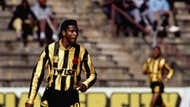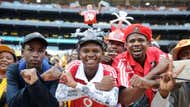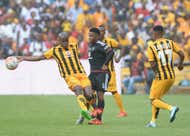Looking for Soccer News?
Kaizer Chiefs vs Orlando Pirates: Unpicking the origins of the mysterious Soweto derby
Why is the meeting between the Soweto giants like no other rivalry in African football?
This weekend, South Africa will be brought to a standstill on Saturday, as Kaizer Chiefs and Orlando Pirates collide in the latest edition of the Soweto derby—the biggest match in the national football calendar.
Despite being one of the most intense rivalries in African football, the collision between the two old foes is a match not quite like any other, as supporters sit side by side and approach the contest with a sense of fraternity and fellowship.
It’s the kind of unity and camaraderie that would be completely alien to supporters of Al-Ahly and SC Zamelek, for example, Egypt’s big two, who contested a fearsome derby of their own on Friday evening.
Similarly, fancy suggesting to fans of Boca Juniors or River Plate, or Glasgow duo Rangers and Celtic that they ought to sit next to one another when derby day rolls around!
Yet despite the violent scenes and mutual animosity that all too regularly accompany these fixtures, the Soweto Derby bears none of this hostility among supporters, and the occasion in fact represents a day of great unity rather than division.
You’ll see plenty of makarapa—the miner’s helmet, adorned with eye-catching decorations—that both fans will wear, there will be vuvuzelas, Pirates’ skull and crossbones, and the black and gold of Chiefs, but there won’t be any of the bitter footballing tribalism that typically characterises derbies across the world.
“As a player, this derby carries the hopes of a nation, we carry the responsibility of the masses” Chiefs legend and Leeds United great Lucas Radebe told Goal back in 2020. “It’s two giants fighting for bragging rights, to determine who stands at the pinnacle of Soweto clubs.
“It goes from the townships to the players and creates a fantastic atmosphere. In some families, there is a lot of division on the day, people sleep without eating and go to bed very sad; that's how deep and rife the rivalry is between the two teams.
“However, the game is turning into an event more than a match itself,” he added. “People go there to enjoy the atmosphere, or to network, they sit together and it’s not as tenacious as it used to be.”
Certainly, the Soweto derby hasn’t always been as ‘friendly’ as it is today.

Early tensions
During the earlier days of the derby, which began with the creation of Kaizer Chiefs in 1970, meetings between the two clubs were too often marred by clashes between rival fans, and battles between supporters before and after games were commonplace until the mid-1980s.
An infamous—if apocryphal—story still does the rounds of one man from Umlazi who killed his sibling when things didn’t go his way in the biennial bout.
“We used to have fights between the supporters in the 1970s,” said Chiefs ‘super fan’ Freddy ‘Saddam’ Maake last year. “Many people lost their lives, some are [still] sitting in wheelchairs.
“In the past, you would sometimes see draws between the two clubs just to avoid the fights and save lives of supporters."
The early tensions can be traced back directly to the formation of Chiefs, which was created by Pirates legend Kaizer Motaung, who created his own breakaway club upon his return from playing in the United States.
His new team included some other former Pirates players who had become disgruntled with and/or had been expelled from the Sea Robbers.
Not only had Bucs lost an icon, but they’d also seen him create a rival side—contenders for Pirates’ supremacy—right on their doorstep.
“When I first joined Pirates in 1989, I was told about the history of the club, the Soweto Derby, the rivalry, and how Kaizer Chiefs were formed,” Bucs legend Ronnie Zondi told Goal in 2020.
“There is no way you'd play for Orlando Pirates and you don't that story. If you are a player and you don't know that story then there's something wrong with you.”
To add salt to the wound, the ambitious Chiefs swiftly generated a passionate and committed fanbase, and the upstarts were league champions as early as 1974.
“Back in the day, supporters didn’t want to sit together in the Soweto Derby,” added Pirates ‘super fan’ Mandla ‘Mgijimi’ Sindane, speaking ahead of a recent derby. “In fact, they would fight, and when you saw someone wearing a [Chiefs] yellow shirt next to you, it was a different situation, we saw fans separated.
“That wasn’t a healthy environment for the kids,” he remembered. “When the two clubs face one another, everyone wants to go to the stadium, but it wasn’t safe for kids, for old people, for anyone at the stadium to watch the Soweto derby.”
Over the years, five derbies have been abandoned for various reasons, while the 1972 Champion of Champions final was overshadowed by skirmishes between supporters, as police dogs were brought onto the pitch to chase fans away.
Later that year, a supported was stabbed to death and English referee Norman Burtenshaw was hit by a beer can thrown from the fans during a league game between the two, and there were pitch invasions and riots which disrupted matches between the two until the mid-1980s.
Despite this, the Soweto derby—illuminated by vibrant characters such as Patrick Ntsoelengoe, Jomo Sono and Ewert ‘The Lip’ Nene—was the centrepiece of South African football’s Golden Years during the 1970s.

A common cause
In 1985, the pair were—together—key drivers in the transition from the dual apartheid-legacy National Soccer League and National Professional Soccer Leagues to the present-day Premier Soccer League as the country shifted from the amateur game to professional football.
For both Pirates and Chiefs, and for the broader South African football community, it was mutually beneficial—if not imperative—that the two giants were on the same page in order to maximise the commercial opportunity and ensure the best sponsorship and broadcast deals for the rest of the league.
During these early discussions, when the terms of the modern PSL were being decided, the Soweto duo acted as ‘big brothers’ for the rest of the division, to ensure that the new league worked for the majority and not exclusively for the privileged pair.
“Our late president Nelson Mandela told us that sport is a unifier,” continued Maake. “I remember [the fans] had to intervene because modern football doesn’t need violence.
“If you don’t want to sit with the supporters of both teams, you must know that you’re a hooligan. We don’t need crime or fights at the stadiums.”
Similarly, the creation of the Vodacom Challenge—a joint venture by Pirates and Chiefs—in the late 1990s played a part in ensuring the derby became a vehicle for unity rather than division.
The exhibition tournament was created as a response to the violence in the strife-torn KwaZulu-Natal province ahead of the 1999 general elections, and the two Soweto rivals decided to take the tournament to the region to compete against other sides from the country and ensure that people came together for a common purpose.
They did, and a show of unity from various national leaders at the event served to soothe the tensions that had embattled the region.
“[Now] there’s that bit of friendship in terms of fans sitting together, enjoying a football match and drinking together,” says Radebe. “This never happened before, where you'd see the stadium going up the flames after a game like this.
“Now it's more of an event than a grudge game."

United in tragedy
Then there were the Orkney Disaster (or Oppenheimer Stadium stampede) of 1991 and the Ellis Park disaster of 2001, two tragedies in which over 80 supporters lost their lives in crushes as they tried to force their way into the stadium to watch the Soweto Derby.
In 2017, history repeated itself, as two people were killed and a further 19 were injured as they tried to get into the stadium ahead of a Carling Black Label Champion Cup clash between the two sides.
Three tragedies—decades apart—have cost 86 lives and united these two fanbases in heartache and, in the second case, a quest for justice following the alleged actions of the South African Police Services.
“It’s not good to count the bodies when we want to count the points,” Maake remembered. “[We knew] we must bridge the gap between the two clubs.”
For Zondi, the Orkney incident was directly responsible for the transformation in the culture of the derby through the 1990s.
“I remember the Orkney incident very well,” he continued. "You’d never find Chiefs and Pirates fans sitting together at any stadium, but what happened in Orkney was that people were encouraged to sit together to try and ease the rivalry and fights.
“However, the fans from either side fought that day, and as others were trying to run away from that corner to another that's when others got hurt and lost their lives and it was discouraged from thereon. It was bad.
"One day, we were playing Chiefs in Atteridgeville, the stadium was packed and we could foresee another stampede because the rivalry was fierce. The game was nearly cancelled but fans were already inside the stadium and it was decided to make it a friendly game.
“The game went ahead, and we were not as competitive in terms of tackles and going forward to want to score, so the fans realised that it was indeed a friendly game.
“The rivalry and fights started getting better, and fans started understanding better.”
In a country as fractured as South Africa, the Soweto Derby has represented a rare show of unity and a positive event and occasion around which fans can unite.
“We had to put the supporters together, and I don’t want to hear anyone saying we must separate,” Maake noted. "We travel together with Pirates supporters to the games, [and there are] no more fights and war between us.
"The people watching at home enjoy the game, and people at the stands must not fight.”
Of course, there is still the pride and disappointment that accompanies any sporting event where passions run high, but the animosity that can forge further divisions and distance among fans in sporting cities across the world does not plague this fixture.


